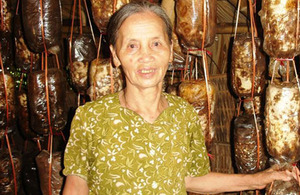Cau's magic mushrooms
Thanks to the Vietnam Challenge Fund programme, supported by UK aid, farmer Cau is starting up her own business

Bags of potential: Mushroom farmer Pham Thi Cau with her produce. Picture: DFID
Pham Thi Cau is a poor farmer in the mountainous area of Yen Bai in northern Vietnam. For years, she struggled to improve her life. But now, thanks to the Vietnam Challenge Fund programme, supported by UK aid from the Department for International Development (DFID), Cau is starting up her own business to produce high quality mushrooms, at the age of 67.
Daily struggle to make ends meet
Cau is a widower and she lives on her own. Her husband passed away many years ago, and all her five children had moved out and settled elsewhere. She earned her living by growing rice and vegetables in a small plot.
“It was just enough to make my ends meet,” she recalls. “Life was really tough.”
Cau also tried different ways to increase her income, including growing acacia, but, with limited resources of cash and labour, the result was not what she had hoped.
In 2009, her total annual income was just £50, topped up by rice and vegetables grown on her small plot of land.
A turning point
The Vietnam Challenge Fund (VCF) was introduced to poor farmers in Yen Bai through a private company whose initiative was to produce high quality mushroom for commercial sales. UK aid funded 49% of the required investment for this project.
Cau was in the first farmer group to join this programme. Although growing mushrooms is not something new in the area, local people, including Cau, mainly grew it for their own consumption.
To change this practice, VCF helped introduce new technology to produce and sell high quality mushrooms - from cultivation to packaging, branding, marketing, and distribution. This approach helped farmers get much greater returns for their efforts.
Cau was then provided with a complete package to start up her business, including inputs needed for production and thorough training for the whole process.
Mushrooming income
Her entire plot has now been given over to mushroom cultivation, hanging some 6,000 mushroom bags. After the first season, Cau received a net income of £330 (ten million Vietnam dong) from just two types of mushroom.
She’s proud of what she has achieved. “This is the first time ever in my life that I have in hand such a big amount of cash,” she says.
A promising future
As growing mushrooms is not as hard as other farming work, Cau is planning to expand the business with more mushroom bags and mushroom varieties. She isn’t worried about the additional labour for this expansion, as members of the farmer group are always able to lend each other a helping hand.
Together with Cau, 150 households in the area are benefiting from this initiative with 300 related jobs being created. Their income is expected to increase by at least 30%.
Cau is looking forward to a bright future: “My life has changed a lot since I started this business. So I will continue growing mushrooms, even after the completion of this project, in order to have a stable income and a better life.”
Film: See how the VCF is changing the lives of poor farmers in Vietnam
Facts and stats
The Vietnam Challenge Fund (VCF) is one of the two main components of the Making Markets Work Better for the Poor (M4P) - a programme funded by UK aid, and administered by the Asian Development Bank. Visit www.markets4poor.org for further information
Launched in late 2009, VCF has been supporting 11 innovative projects proposed by the private sector that involve and benefit the poor.
The “Production of Commercial Mushrooms and Mushroom Seeds in Yen Bai” was among these projects. It brought a new model of mushroom production, with a focus on adding value to the produce throughout the process.
The project initially aims to involve 150 households, creating jobs for 300 poor people, and is expected to increase their income by at least 30% to allow them to escape poverty.